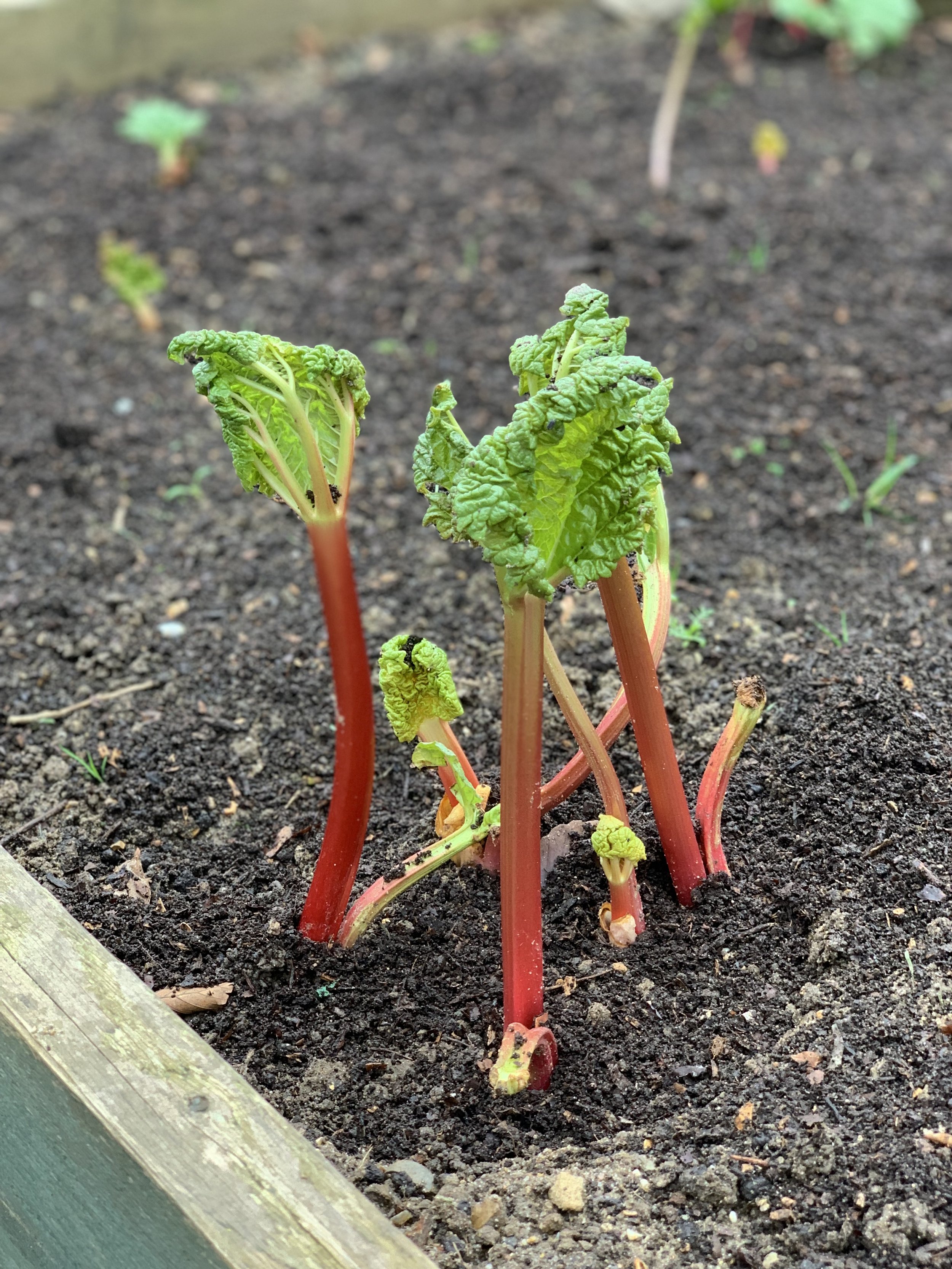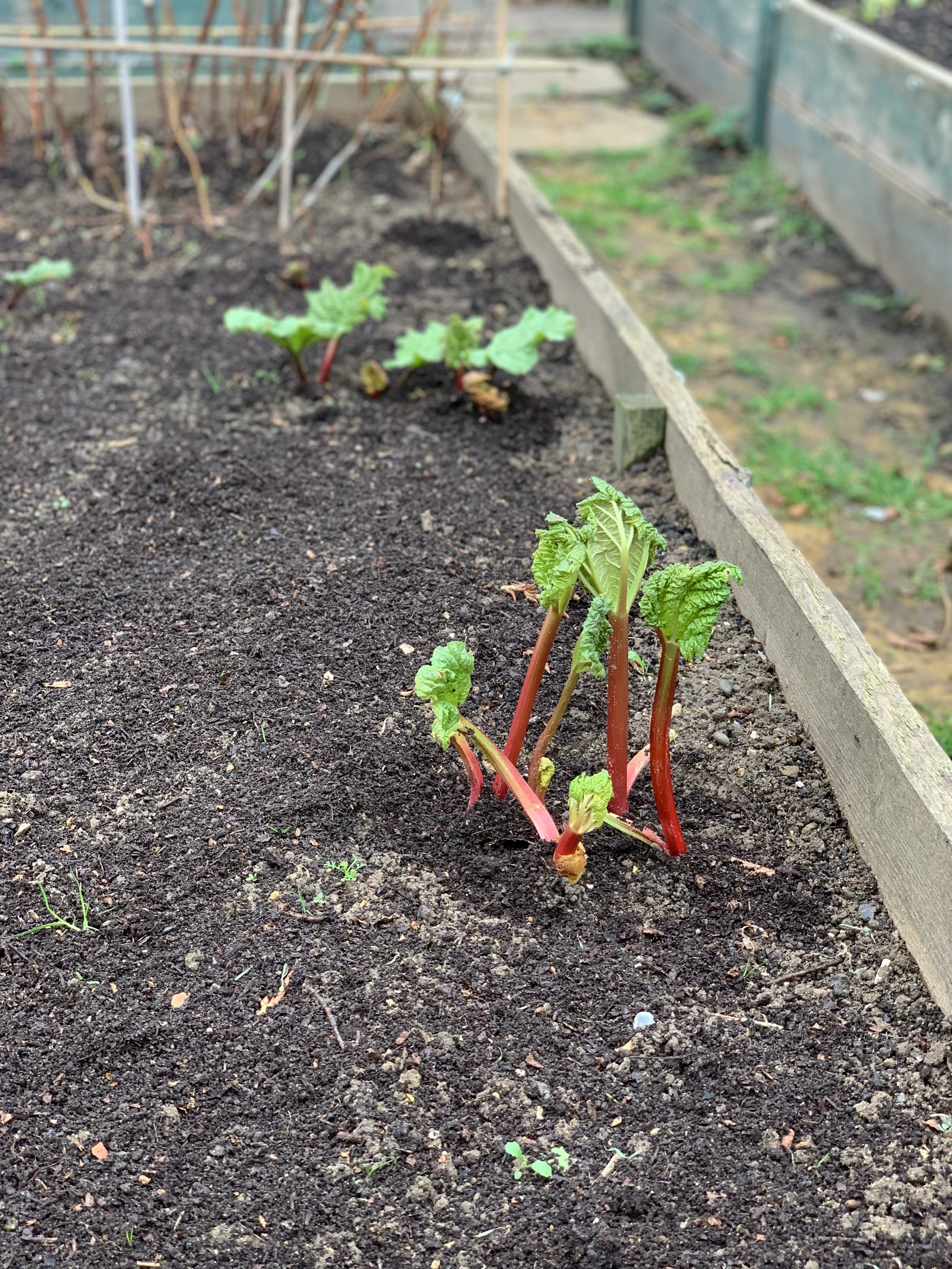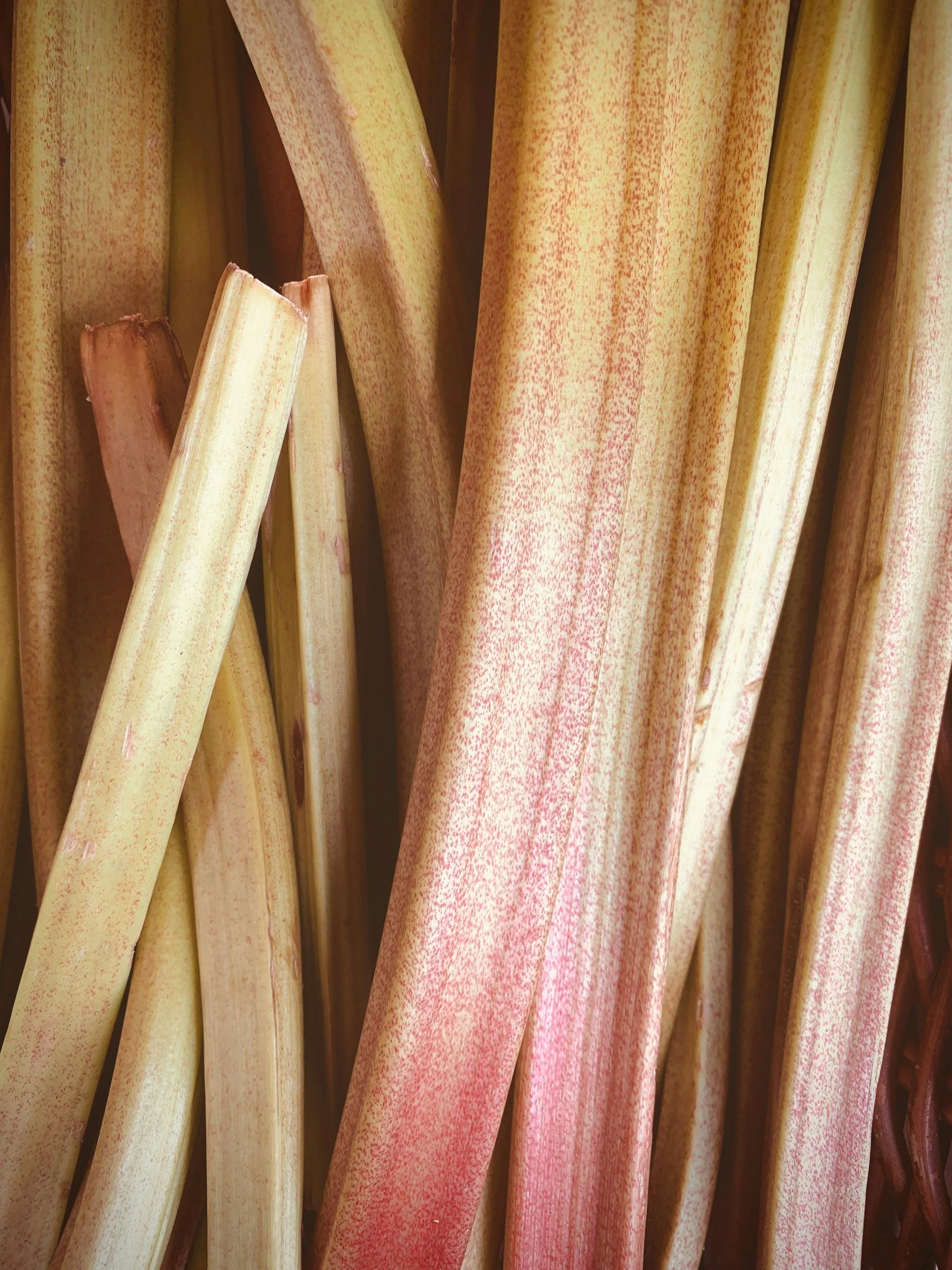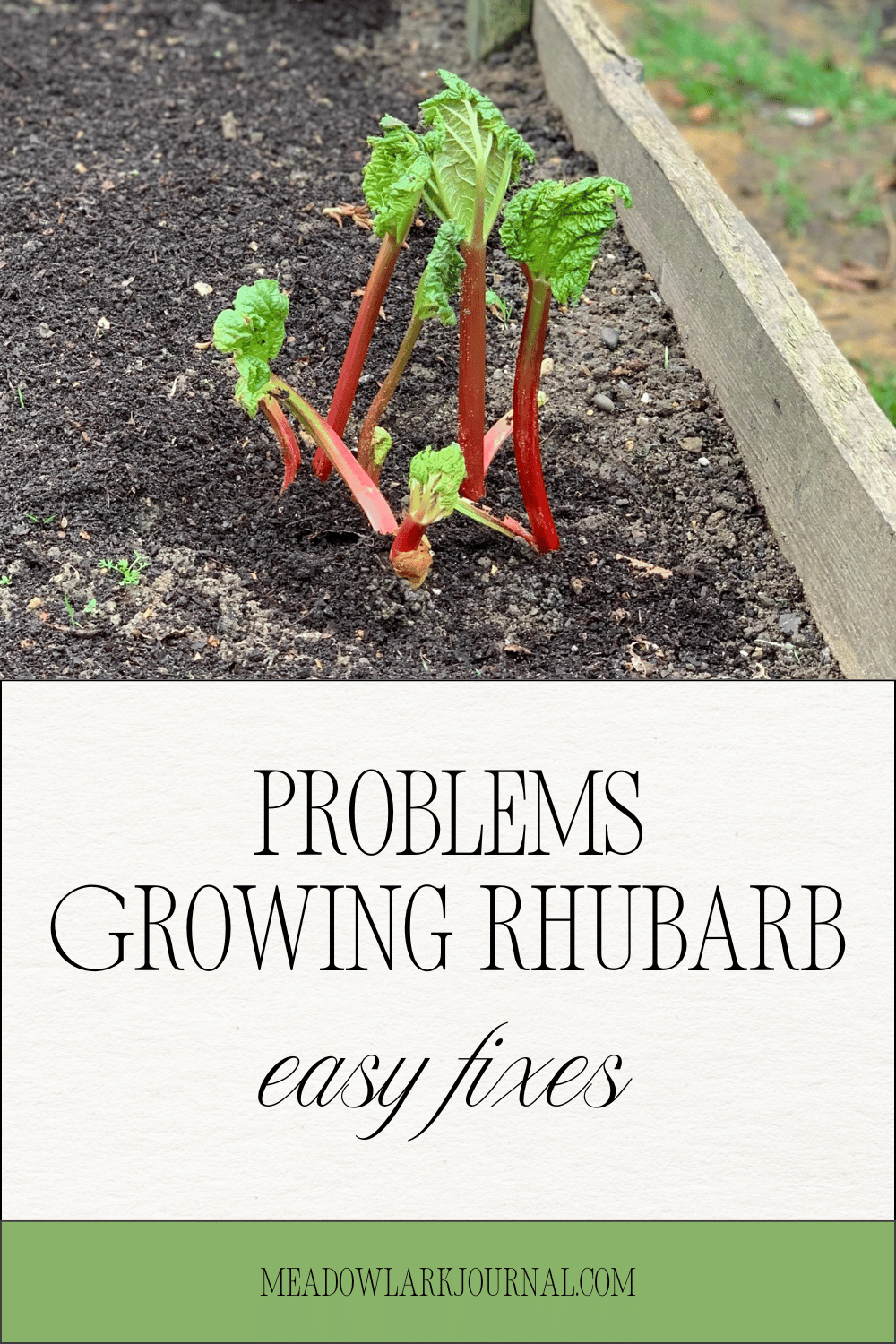Problems Growing Rhubarb: Simple Fixes
This website is reader-supported - thank you! This post may contain affiliate links. As an Amazon Associate, I earn from qualifying purchases at no extra cost to you.
Growing your own rhubarb can be really rewarding, but it's not without its challenges.
It is easy to encounter problems growing rhubarb, ranging from pest infestations to nutrient deficiencies.
Understanding these common issues and how to address them is key to cultivating healthy, productive rhubarb plants.
In this guide, we'll explore various problems you might face when growing rhubarb and offer practical solutions to keep your plants thriving.
To learn more about growing rhubarb, check out my guide:
Poor Soil Conditions
Rhubarb plants thrive in rich, well-drained soil.
Poor soil conditions can severely impact the health and productivity of your rhubarb.
Here are some key points to consider:
Soil Composition
Rhubarb requires soil that is high in organic matter.
This means that the soil should be rich in decomposed plant material and nutrients.
If your soil is sandy or clay-heavy, it may not provide the necessary nutrients or drainage for healthy rhubarb growth.
Improving Soil Fertility
To enhance the soil quality, incorporate plenty of organic matter before planting.
This can be achieved by adding compost, well-rotted manure, or leaf mold to the soil.
These materials not only improve the nutrient content but also enhance soil structure, aiding in better water retention and drainage.
Check out my guide: A Simple Recipe for Rich Compost Tea.
Soil pH
Rhubarb prefers slightly acidic to neutral soil, with a pH range of 6.0 to 6.8.
You can test your soil’s pH using a home testing kit.
If the pH is too low (acidic), adding lime can help raise it.
Conversely, if the pH is too high (alkaline), incorporating sulfur or organic matter can help lower it.
Here is the soil pH home testing kit I recommend using:
Drainage
Good drainage is crucial for rhubarb plants.
Waterlogged soil can lead to root rot and other diseases.
To improve drainage, you can:
Raised Beds:
Planting rhubarb in raised beds can help prevent waterlogging, as the elevated soil drains more effectively.
To learn more about growing in raised beds, check out my guide: The Best Vegetables to Grow in a Raised Bed from Seed.
Soil Amendments:
Mixing sand or fine gravel into heavy clay soil can improve drainage.
However, ensure that the soil doesn't become too sandy, as this can reduce nutrient availability.
Mulching
Applying mulch around your rhubarb plants can help maintain soil moisture, suppress weeds, and add organic matter as it breaks down.
Use materials such as straw, wood chips, or compost.
Mulch also helps to moderate soil temperature, providing a more stable growing environment for your plants.
Here is the mulch I recommend for rhubarb:
Regular Soil Maintenance
Regularly testing and amending your soil can keep it in optimal condition for growing rhubarb.
Each year, add a layer of compost or well-rotted manure to replenish nutrients and maintain soil health.
This practice will support robust growth and abundant rhubarb stalks.
Check out my guide: How to Start Composting in a Tumbler.
Equip your urban garden space with my recommend top tier tools.
Crown Rot
Crown rot is one of the most common and damaging problems that can affect rhubarb plants.
This fungal disease, often caused by species such as Phytophthora and Fusarium, leads to the decay of the plant's crown—the part of the plant where the stem meets the root.
Here are some key points to understand and manage crown rot:
Symptoms of Crown Rot
Identifying crown rot early can help save your rhubarb plants.
Common symptoms include:
Mushy, Discolored Crowns:
The crown becomes soft, mushy, and brown or black in color.
Wilting and Yellowing Leaves:
Leaves may start to wilt and turn yellow as the disease progresses.
Stunted Growth:
Infected plants often exhibit stunted growth and may not produce new stalks.
Foul Odor:
Severely affected crowns may emit a foul odor due to the decay.
Causes of Crown Rot
Crown rot is typically caused by several factors that promote fungal growth:
Poor Drainage:
Waterlogged soil provides an ideal environment for fungal pathogens to thrive.
Overwatering:
Excessive watering can lead to saturated soil conditions, exacerbating the problem.
Infected Soil or Plants:
Planting rhubarb in soil that previously hosted infected plants can spread the disease.
Injured Crowns:
Damage to the crown, whether from improper planting or physical injury, can create entry points for fungal pathogens.
Preventing Crown Rot
Prevention is the best strategy against crown rot.
Here are several practices to minimize the risk:
Ensure Proper Drainage:
Plant rhubarb in well-drained soil or raised beds to avoid waterlogged conditions.
Amend heavy soils with organic matter or sand to improve drainage.
Avoid Overwatering:
Water rhubarb plants only as needed.
During rainy periods, ensure that water does not pool around the plants.
For more watering tips, check out my guide: Water Butts: Sustainable Water Storage for Your Garden.
Use Healthy Plants:
Start with disease-free crowns and plants.
Purchasing rhubarb crowns from reputable sources can reduce the risk of introducing pathogens.
Proper Planting Techniques:
Plant rhubarb crowns at the right depth, ensuring that the top of the crown is just above the soil surface.
Avoid burying the crown too deeply.
Clean Gardening Tools:
Disinfect tools before and after use to prevent the spread of pathogens.
Managing Crown Rot
If crown rot has already affected your rhubarb plants, prompt action is required:
Remove Infected Plants:
Carefully dig up and dispose of infected plants to prevent the disease from spreading to healthy plants.
Improve Soil Conditions:
After removing infected plants, amend the soil with organic matter to improve drainage and reduce fungal spore levels.
Crop Rotation:
Avoid planting rhubarb in the same spot where infected plants were previously grown.
Practice crop rotation to reduce the buildup of soil-borne pathogens.
Replanting After Crown Rot
Before replanting rhubarb in an area affected by crown rot:
Wait and Prepare the Soil:
Allow the soil to recover for a season and amend it with compost or well-rotted manure to enhance fertility and drainage.
Choose Resistant Varieties:
Consider planting rhubarb varieties that are more resistant to fungal diseases.
A good example is ‘Crimson Red’. This variety is also resistant to crown rot and produces tender, deep red stalks.
It is known for its high yield and excellent flavor.
Monitor New Plants:
Keep a close eye on new rhubarb plants for any signs of crown rot and address issues promptly.
Leaf Spot
Leaf spot is a common fungal disease that affects rhubarb leaves, leading to reduced vigor and aesthetic quality of the plants.
It is primarily caused by fungi such as Ascochyta and Ramularia.
Understanding how to identify, prevent, and manage leaf spot can help maintain the health and productivity of your rhubarb plants.
Symptoms of Leaf Spot
Identifying leaf spot early is crucial for effective management.
Look for the following symptoms:
Brown or Black Spots:
The most noticeable sign is the appearance of small, brown or black spots on the leaves.
These spots may have a yellow halo around them.
Lesions:
The spots can merge, forming larger lesions that cause significant damage to the leaf tissue.
Yellowing Leaves:
Infected leaves may turn yellow and wither as the disease progresses.
Defoliation:
Severe infections can cause premature leaf drop, weakening the plant.
Causes of Leaf Spot
Leaf spot is favored by specific environmental conditions and practices:
High Humidity and Wet Conditions:
Fungi thrive in moist environments.
Prolonged periods of wetness, whether from rain, irrigation, or dew, can promote the development of leaf spot.
Poor Air Circulation:
Crowded plants with poor airflow are more susceptible to fungal infections.
Infected Plant Debris:
Fungal spores can survive in plant debris left on the ground, leading to new infections the following growing season.
Preventing Leaf Spot
Preventative measures can significantly reduce the incidence of leaf spot:
Proper Spacing:
Ensure adequate spacing between plants to promote good air circulation, which helps to keep the leaves dry.
Watering Techniques:
Water the base of the plants rather than overhead to keep the foliage dry.
Water in the morning so that any moisture on the leaves dries quickly.
For more watering tips, check out my guide: How to Use Watering Globes.
Remove Plant Debris:
Regularly remove and dispose of fallen leaves and plant debris to reduce the presence of fungal spores in the garden.
Crop Rotation:
Practice crop rotation and avoid planting rhubarb in the same spot where leaf spot was previously an issue.
Managing Leaf Spot
If leaf spot appears on your rhubarb plants, take the following steps to manage the disease:
Remove Infected Leaves:
Carefully remove and destroy infected leaves to prevent the spread of the disease.
Do not compost these leaves, as the fungal spores can survive and reinfect the garden.
Improve Plant Health:
Healthy plants are more resistant to diseases.
Ensure your rhubarb receives adequate nutrition and water, but avoid overwatering.
Long-Term Management
For long-term control of leaf spot:
Resistant Varieties:
If available, consider planting rhubarb varieties that are resistant to leaf spot.
‘Canada Red’ is a good resistant variety.
Healthy Soil Practices:
Maintain healthy soil through regular addition of compost and organic matter, which can enhance plant health and resistance to diseases.
Monitoring:
Regularly inspect your rhubarb plants for early signs of leaf spot and other diseases, allowing for prompt action to prevent widespread issues.
Inadequate Sunlight
Rhubarb is a robust perennial that thrives under the right growing conditions, one of which is adequate sunlight.
Understanding the sunlight needs of rhubarb and the implications of inadequate sunlight can help ensure your plants grow strong and healthy.
Sunlight Requirements
Rhubarb plants require a significant amount of sunlight to flourish:
Full Sun to Partial Shade:
Rhubarb does best when it receives full sun, which means at least 6-8 hours of direct sunlight per day.
A south-facing, west-facing, or south-west facing garden position is best.
However, it can tolerate partial shade, especially in regions with very hot summers.
Morning Sun:
Ideally, rhubarb should receive morning sunlight, which is less intense and helps the plants dry off morning dew, reducing the risk of fungal diseases.
Effects of Inadequate Sunlight
Lack of sufficient sunlight can lead to several problems:
Weak Growth:
Without enough sunlight, rhubarb plants may exhibit weak, spindly growth.
The stalks might be thin and less robust, making them less desirable for harvesting.
Poor Color:
Rhubarb stalks grown in inadequate sunlight may be pale and less vibrant in color, which can affect their visual appeal and potentially their taste.
Reduced Yield:
Sunlight is essential for photosynthesis, the process by which plants convert sunlight into energy.
Insufficient sunlight can lead to reduced energy production, resulting in lower yields.
Increased Susceptibility to Disease:
Plants weakened by lack of sunlight are more susceptible to pests and diseases.
Their natural defenses are compromised, making them more vulnerable to infections like crown rot and leaf spot.
Optimizing Sunlight Exposure
To ensure your rhubarb plants receive adequate sunlight, consider the following tips:
Choose the Right Location:
Select a planting site that receives full sun for most of the day.
Avoid areas with heavy shade from trees or buildings.
Consider Seasonal Changes:
Be mindful of how the position of the sun changes with the seasons.
A spot that receives full sun in spring might become shaded in summer due to the position of the sun and the growth of surrounding vegetation.
Manage Surrounding Vegetation:
Trim back any overhanging branches or nearby plants that might cast shadows on your rhubarb.
This will help maximize the amount of sunlight reaching the plants.
Use Reflective Mulch:
In areas where full sun is not possible, using reflective mulch can help increase light exposure.
Here is the reflective mulch I recommend:
Alternative Solutions
If you are unable to provide full sun, there are alternative solutions to support rhubarb growth:
Partial Shade Tolerance:
In hot climates, rhubarb can benefit from some afternoon shade to protect it from intense heat.
In such cases, ensuring the plants get sufficient morning sunlight is crucial.
Container Growing:
If your garden lacks a suitable sunny spot, consider growing rhubarb in large containers that can be moved to sunnier areas as needed.
This allows for greater control over sunlight exposure.
Monitoring and Adjusting
Regularly monitor your rhubarb plants to ensure they are getting the light they need:
Observe Growth Patterns:
Take note of any changes in growth patterns, such as elongated stalks or pale leaves, which may indicate inadequate sunlight.
Adjust as Necessary:
If you notice signs of insufficient sunlight, consider relocating your plants or adjusting the surrounding environment to increase light exposure.
Pest Issues
Pest issues can significantly impact the health and productivity of your rhubarb plants.
Various pests can attack rhubarb, causing damage to the leaves and stalks, and sometimes spreading diseases.
Here’s how to identify, prevent, and manage common pests that affect rhubarb.
Common Rhubarb Pests
Several pests are known to target rhubarb plants:
Aphids:
Identification:
Small, soft-bodied insects that come in various colors (green, black, red).
They often cluster on the underside of leaves and on new growth.
Damage:
Aphids suck sap from the plant, causing leaves to curl, yellow, and become distorted.
They can also secrete honeydew, which attracts ants and promotes sooty mold growth.
Slugs and Snails:
Identification:
Slimy, soft-bodied mollusks that are most active during the night or in damp, overcast conditions.
Damage:
These pests chew irregular holes in the leaves and can cause significant damage to young plants and seedlings.
Caterpillars:
Identification:
The larval stage of various moths and butterflies.
Caterpillars are typically green or brown and have a segmented, worm-like appearance.
Damage:
Caterpillars chew holes in leaves, sometimes skeletonizing them, which weakens the plant.
Rhubarb Curculio:
Identification:
A type of weevil, typically about 1/2 inch long, with a black or dark brown body and a long snout.
Damage:
These pests feed on the leaves and stalks, causing notches and holes.
They also lay eggs in the stalks, leading to further damage as the larvae develop.
Managing Pest Infestations
If pests are already present, consider these management strategies:
Aphids:
Natural Predators:
Encourage beneficial insects like ladybugs and lacewings, which feed on aphids.
Insecticidal Soap:
Spray plants with insecticidal soap or a homemade mixture of water and mild dish soap to kill aphids on contact.
Here is the insecticidal soap I recommend:
Slugs and Snails:
Hand Picking:
Collect slugs and snails by hand in the evening or early morning and dispose of them.
Caterpillars:
Manual Removal: Handpick caterpillars from plants and dispose of them.
Rhubarb Curculio:
Remove Affected Stalks:
Cut and dispose of any stalks showing signs of curculio damage to prevent the spread.
Beneficial Nematodes:
Introduce beneficial nematodes into the soil to target the larval stage of the curculio.
General Pest Management Tips:
Companion Planting:
Planting garlic, onions, or marigolds near rhubarb can help repel pests
To learn more about this, check out my guide: Rhubarb Companion Planting: Do's and Don'ts.
Regular Monitoring:
Inspect your plants regularly for signs of pests. Early detection can prevent minor issues from becoming major infestations.
Nutrient Deficiencies
Nutrient deficiencies can severely impact the growth and productivity of rhubarb plants.
Identifying and addressing these deficiencies is crucial for maintaining healthy, vigorous plants that produce bountiful stalks.
Here’s how to recognize, prevent, and treat common nutrient deficiencies in rhubarb.
Nitrogen Deficiency:
Symptoms:
Yellowing of older leaves, stunted growth, and poor overall vigor.
Solution:
Apply a nitrogen-rich fertilizer, such as blood meal, fish emulsion, or a balanced N-P-K fertilizer.
Here is the fertilizer I recommend to help with this:
Phosphorus Deficiency:
Symptoms:
Dark green or purplish leaves, especially on the undersides, stunted root growth, and reduced stalk production.
Solution:
Add bone meal, rock phosphate, or a phosphorus-rich fertilizer to the soil.
Here is the bone meal I recommend:
Potassium Deficiency:
Symptoms:
Yellowing or browning of leaf edges, weak stalks, and poor disease resistance.
Solution:
Incorporate potassium-rich amendments like potash, wood ash, or a potassium-based fertilizer.
Here is the potash I recommend:
Calcium Deficiency:
Symptoms:
Blossom end rot, poor root development, and necrosis at leaf tips and edges.
Solution:
Apply lime or gypsum to the soil to increase calcium levels.
Here is the lime I recommend:
Magnesium Deficiency:
Symptoms:
Interveinal chlorosis (yellowing between leaf veins) on older leaves, reduced plant growth.
Solution:
Use Epsom salts or a magnesium-containing fertilizer.
Here is the Epsom salt I recommend:
Iron Deficiency:
Symptoms:
Interveinal chlorosis on young leaves, overall chlorosis.
Solution:
Apply chelated iron or iron sulfate to the soil or as a foliar spray.
Preventing Nutrient Deficiencies
Preventing deficiencies involves maintaining soil health and providing balanced nutrition:
Soil Testing:
Regular Testing:
Conduct soil tests every few years to determine nutrient levels and pH.
This helps tailor your fertilization plan to your garden's specific needs.
pH Balance:
Ensure soil pH is in the optimal range for rhubarb (6.0 to 6.8). Adjust pH with lime (to raise) or sulfur (to lower) as needed.
Here is the soil pH test kit I recommend:
Crop Rotation and Cover Crops:
Rotation:
Rotate crops to avoid depleting specific nutrients. Avoid planting rhubarb in the same spot for consecutive years.
Cover Crops:
Grow cover crops like clover or peas to fix nitrogen in the soil and add organic matter when tilled under.
Quick FAQs
How do I control crown rot in rhubarb plants?
Ensure your soil has good drainage, avoid overwatering, and remove any affected plants to prevent the spread of crown rot.
Should you let rhubarb flower?
It's best to remove flower stalks as soon as they appear to encourage the plant to focus its energy on producing edible stalks rather than flowers.
Can you eat rhubarb leaves?
No, rhubarb leaves are toxic and should not be eaten. Only the stalks are safe for consumption.
How do you force rhubarb?
Forcing rhubarb involves covering the crowns with an inverted pot or forcing jar to encourage early growth.
Forced rhubarb is typically done in late winter or early spring.
What is the best fertilizer for rhubarb?
A balanced fertilizer with equal parts nitrogen, phosphorus, and potassium is ideal for rhubarb.
Apply it in early spring for the best results.
Here is the balanced fertilizer I recommend:
Does rhubarb need a lot of sun?
Rhubarb thrives in full sun to partial shade.
Ensure your plants get at least six hours of sunlight per day for optimal growth.
How can I get rid of rhubarb if I no longer want it in my garden?
Dig up the crowns and roots thoroughly to remove rhubarb from your garden. Regularly check for and remove any regrowth.
Does rhubarb spread?
While rhubarb crowns do not spread like some other plants, they do grow larger each year.
It's important to divide your rhubarb crowns every 4-5 years to maintain healthy plants and prevent overcrowding.
Pin this post to save it for later!














































